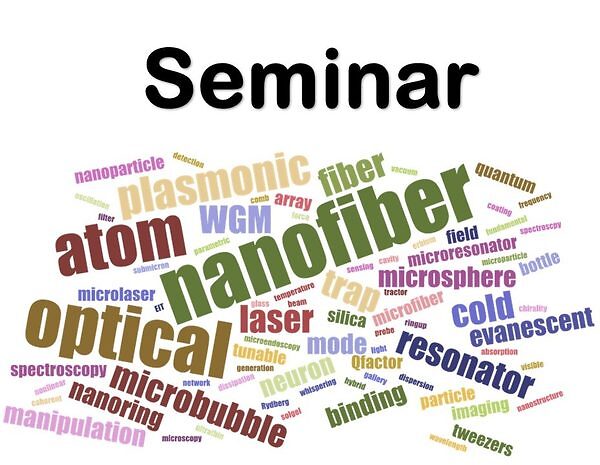Seminar by Prof Chen‐Bin (Robin) Huang 'Optical vortex creation and nonlinear frequency conversion in plasmonic devices'

Date
Location
Description
Speaker: Dr Chen‐Bin (Robin) Huang
Professor, Institute of Photonics Technologies, Department of Electrical Engineering, National Tsing Hua University, Taiwan
Talk title: Optical vortex creation and nonlinear frequency conversion in plasmonic devices
Abstract:
Surface plasmons (SPs) are evanescent waves generated through the collective oscillations of
electrons at a metal/dielectric interface under optical excitation. Due to the strong light‐
electron coupling and near‐field nature, surface plasmons offer: (1) the opportunity for sub‐
wavelength spatial confinement of optical waves is enabled; and (2) giant local field
enhancement of optical waves is permitted. These unique attributes lead to the long‐
envisaged optical circuits, and allowed breakthroughs in the generally termed “plasmonics”.
Optical vortices are waves carrying orbital angular momentum and exhibit helical phase
fronts. Generation of optical beams carrying orbital angular momentum has received
increasing attentions recently, both in the far‐field and in the near‐field. In this talk, I will first
introduce our recent progress on applying surface plasmon vortex for selectable particle
trapping and rotation. The ability to spatially shape the near‐field spatial patterns of surface
plasmon vortices will be addressed as well. Next, I will focus on the creation of surface
plasmon vortex using non‐angular momentum excitation.
As documented in all nonlinear optics textbooks, second‐harmonic generation from a
bulk material requires a non‐centro‐symmetric crystal structure. With the emerging of
nonlinear nano‐optics, this rule has to be refined: nanoparticles with a non‐symmetric shape
allow second‐harmonic generation even for centro‐symmetric materials. An interesting
question remains to be addressed is “Is second‐harmonic generation possible with centro‐
symmetric nanostructures made of a centro‐symmetric material?” In the second part of the
talk, I’ll address and introduce a brand new third way: combining symmetric and anti‐
symmetric optical modes, not geometry, to permit emission of second‐harmonic light from a
fully symmetric nanocircuit formed by a centro‐symmetric material.
Biography
Chen‐Bin Huang received his B.S. degree in electrical engineering from National Tsing Hua University,
Taiwan, in 1997, his M.S. degree in electro‐optical engineering from National Chiao Tung University,
Taiwan, in 1999, and his Ph.D. degree from the School of Electrical and Computer Engineering at Purdue
University, West Lafayette, IN, USA, in 2008.
He has worked at Bell Laboratories (Alcatel‐Lucent) in the USA and the Opto‐Electronics & Systems
(OES) Laboratories of the Industrial Technology Research Institute (ITRI) in Taiwan. He joined the
Institute of Photonics Technologies at National Tsing Hua University in Taiwan as assistant professor in
2008. He was promoted to associate professor in 2012, and to professor in 2016. He has worked as
visiting scientist at University of Pittsburgh, Chinese Academy of Sciences, University of Bayreuth,
University of Würzburg, and at Northwestern University. His current research interests include
plasmonics, ultrafast optics, nonlinear optics, and millimeter‐wave photonics.
Subscribe to the OIST Calendar: Right-click to download, then open in your calendar application.



